Available S-Parameters
This informational dialog shows the S-parameters that are available for your specific DUT setup diagram (shown in the TDR Setup dialog). These available S-parameters can be selected for display in the TDR Setup dialog.
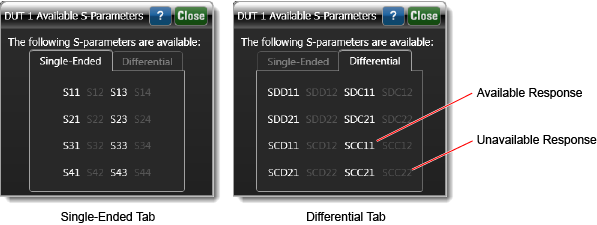
For differential setups, the dialog shows both the available single-ended and differential S-parameters that can be displayed. For single-ended setups, the dialog only includes the available single-ended S-parameters.
The dialog identifies all possible S-parameters, which are determined by the number of ports on the DUT. S-parameters become available (highlighted) by activating TDR steps in the DUT setup diagram. Only those parameters that are highlighted are available for display. Parameters that are dim are not available. For example, in the above pictures the S11 and SDD11 responses are available but the S12 and SDD12 responses are not. To enable more responses, you must turn on the associated TDR steps in the DUT setup diagram.
The following examples show all of the S-parameters that could be available for selected DUTs. If you are unfamiliar with S-parameter names, you may find this section helpful.
Example of S-Parameters on Single-Ended 4-Port DUT
There are 16 possible S-Parameter responses for this DUT. When using an N1055A TDR module, all 16 responses could be simultaneously displayed.
| DUT Setup Diagram | S-Parameter | Response Description |
|---|---|---|
Port 1 Step: On |
S11 | Return loss |
| S21 | Insertion loss | |
| S31 | Near-end cross talk | |
| S41 | Far-end cross talk | |
Port 2 Step: On |
S12 | Insertion loss |
| S22 | Return loss | |
| S32 | Far-end cross talk | |
| S42 | Near-end cross talk | |
Port 3 Step: On |
S13 | Near-end cross talk |
| S23 | Far-end cross talk | |
| S33 | Return loss | |
| S43 | Insertion loss | |
Port 4 Step: On |
S14 | Far-end cross talk |
| S24 | Near-end cross talk | |
| S34 | Insertion loss | |
| S44 | Return loss |
Example of S-Parameters on Differential 2-Port DUT
There are 16 possible differential and common-mode S-parameter responses for this DUT. Because this is a differential DUT, 16 single-ended S-Parameter responses are also available. Therefore, there are a total of 32 possible S-parameters for this DUT. When using an N1055A TDR module, all 32 responses can be simultaneously displayed.
| DUT Setup Diagram | S-Parameter | Response Description | S-Parameter | Response Description |
|---|---|---|---|---|
Port 1 Step: On |
Differential Stimulus | Commom-Mode Stimulus | ||
| SDD11 | Diff. return loss | SDC11 | Diff. return loss | |
| SDD21 | Diff. insertion loss | SDC21 | Diff. insertion loss | |
| SCD11 | Comm. return loss | SCC11 | Comm. return loss | |
| SCD21 | Comm. insertion loss | SCC21 | Comm. insertion loss | |
Port 2 Step: On |
Differential Stimulus | Commom-Mode Stimulus | ||
| SDD12 | Diff. insertion loss | SDC12 | Diff. insertion loss | |
| SDD22 | Diff. return loss | SDC22 | Diff. return loss | |
| SCD12 | Comm. insertion loss | SCC12 | Comm. insertion loss | |
| SCD22 | Comm. return loss | SCC22 | Comm. return loss | |
Example of S-Parameters on Differential 4-Port DUT
For this DUT, a total of 128 S-parameter responses are possible including 64 single-ended and 64 differential! These is a maximum limit of 64 responses can be acquired at a single time. So, when two N1055A modules are used, all eight cables are connected to the DUT but only two TDR incident steps can be activated.
| DUT Setup Diagram | S-Parameter | Response Description | S-Parameter | Response Description |
|---|---|---|---|---|
Port 1 Step: On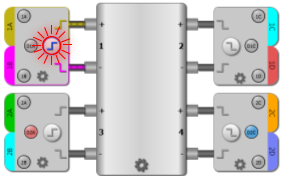 |
Differential Stimulus | Common-Mode Stimulus | ||
| SDD11 | Diff. return loss | SDC11 | Diff. return loss | |
| SDD21 | Diff. insertion loss | SDC21 | Diff. insertion loss | |
| SDD31 | Diff. near-end cross talk | SDC31 | Diff. near-end cross talk | |
| SDD41 | Diff. far-end cross talk | SDC41 | Diff. far-end cross talk | |
| SCD11 | Comm. return loss | SCC11 | Comm. return loss | |
| SCD21 | Comm. insertion loss | SCC21 | Comm. insertion loss | |
| SCD31 | Comm. near-end cross talk | SCC31 | Comm. near-end cross talk | |
| SCD41 | Comm. far-end cross talk | SCC41 | Comm. far-end cross talk | |
Port 2 Step: On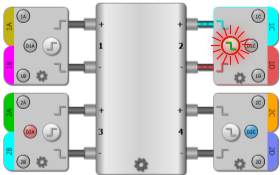 |
Differential Stimulus | Common-Mode Stimulus | ||
| SDD12 | Diff. insertion loss | SDC12 | Diff. insertion loss | |
| SDD22 | Diff. return loss | SDC22 | Diff. return loss | |
| SDD32 | Diff. far-end cross talk | SDC32 | Diff. far-end cross talk | |
| SDD42 | Diff. near-end cross talk | SDC42 | Diff. near-end cross talk | |
| SCD12 | Comm. insertion loss | SCC12 | Comm. insertion loss | |
| SCD22 | Comm. return loss | SCC22 | Comm. return loss | |
| SCD32 | Comm. far-end cross talk | SCC32 | Comm. far-end cross talk | |
| SCD42 | Comm. near-end cross talk | SCC42 | Comm. near-end cross talk | |
Port 3 Step: On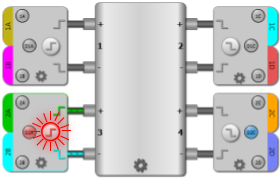 |
Differential Stimulus | Common-Mode Stimulus | ||
| SDD13 | Diff. near-end cross talk | SDC13 | Diff. near-end cross talk | |
| SDD23 | Diff. far-end cross talk | SDC23 | Diff. far-end cross talk | |
| SDD33 | Diff. return loss | SDC33 | Diff. return loss | |
| SDD43 | Diff. insertion loss | SDC43 | Diff. insertion loss | |
| SCD13 | Comm. near-end cross talk | SCC13 | Comm. near-end cross talk | |
| SCD23 | Comm. far-end cross talk | SCC23 | Comm. far-end cross talk | |
| SCD33 | Comm. return loss | SCC33 | Comm. return loss | |
| SCD43 | Comm. insertion loss | SCC43 | Comm. insertion loss | |
Port 4 Step: On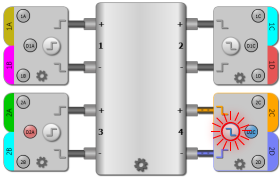 |
Differential Stimulus | Common-Mode Stimulus | ||
| SDD14 | Diff. far-end cross talk | SDC14 | Diff. far-end cross talk | |
| SDD24 | Diff. near-end cross talk | SDC24 | Diff. near-end cross talk | |
| SDD34 | Diff. insertion loss | SDC34 | Diff. insertion loss | |
| SDD44 | Diff. return loss | SDC44 | Diff. return loss | |
| SCD14 | Comm. far-end cross talk | SCC14 | Comm. far-end cross talk | |
| SCD24 | Comm. near-end cross talk | SCC24 | Comm. near-end cross talk | |
| SCD34 | Comm. insertion loss | SCC34 | Comm. insertion loss | |
| SCD44 | Comm. return loss | SCC44 | Comm. return loss | |